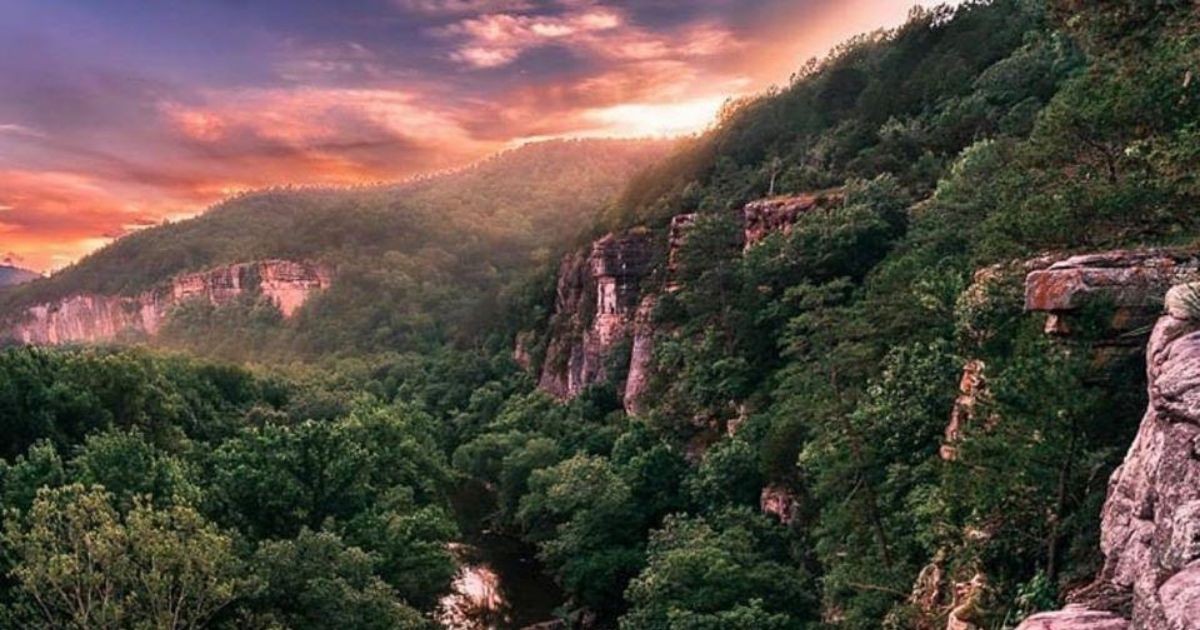The Buffalo National River, widely acclaimed for its stunning beauty and the title of America’s first national river, is a favorite destination in Northwest Arkansas, but did you know these unique factoids about the area?
Fact: 180 million year old fossil record
According to the National State Park Service, the Buffalo National River is home to a fossil record that spans over 180 million years, from the time when life only existed in the seas to the emergence of the first trees and ferns. The most interesting fossils found in the park are those of crinoids, which are ancient sea creatures related to starfish and sea urchins. Crinoids were abundant in the Buffalo River during the Paleozoic Era, and their fossils can be found in many of the park’s rock formations. The Conard Fissure, a significant fossil site near the park excavated in 1908, yielded fifteen specimens of saber-tooth cats, multiple other big cats, bears, peccaries, giant armadillos, and hundreds of pounds of additional bone material, most of which now reside at the American Museum of Natural History in New York City.
Fact: Home to 200 bird species + 55 species of mammals
Did you know the Buffalo River has approximately 200 species of birds and 55 species of mammals? Designated by Audubon Arkansas as an Important Bird Area in 2016, the Buffalo National River serves as a critical habitat for breeding, wintering, and migrating bird species—including the Bald Eagle, Northern Bobwhite, Cerulean Warbler, Swainson’s Warbler, and Louisiana Waterthrush. It is commonly known that around 500 Rocky Mountain Elk, the state’s only elk herd, call the Buffalo River corridor home, but did you know about the river otters? Yes, river otters hang out and hunt together in and around the river.
Fact: Originally named Buffalo Fork
“Have you ever wondered how the Buffalo National River got its name? You guessed it! Buffalo! Scientifically speaking, there are no buffalo in North America.”
According to the National State Park Service, the origin of the name doubtless stemmed from the common occurrence of the American bison in the vicinity of the Buffalo. Until around 1820, the animal thrived along the northern and western portions of the Arkansas Territory. The word buffalo is derived from the French “bœuf,” a name given to bison when French fur trappers working in the US in the early 1600s saw the animals. The word bœuf came from what the French knew as true buffalo, animals living in Africa and Asia. Spanish land grant documents from 1793 refer to the area as “Cibolo,” Spanish for American buffalo. Even though the Buffalo River region stayed largely untouched and unpopulated until the 1820s, its name, or more specifically “Buffalo Fork of the White River,” made its debut on a topographical map as early as 1810.
Fact: International Dark Sky Park
There is officially no better place in Northwest Arkansas to gaze at the stars than the Buffalo National River. In 2019, after a collective effort by park staff and volunteers to lower the park’s use of artificial light at night, the river earned the designation of an International Dark Sky Park (IDSP) from the International Dark-Sky Association (IDA). The Buffalo National River is the first in Arkansas, 26th National Park Service site, and 71st in the world to receive the designation.
Speaking of, The Arkansas Natural Sky Association and various regional astronomy and environmental groups are hosting the 2023 Arkansas Dark-Sky Festival from September 14-16 at Bear Creek. The three-night festival under the Summer Milky Way is free, but you must register to attend. The featured speaker for the 2023 Dark-Sky Festival will be Dr. Amber Straughn, an Astrophysicist at NASA’s Goddard Space Flight Center in Greenbelt, MD.












